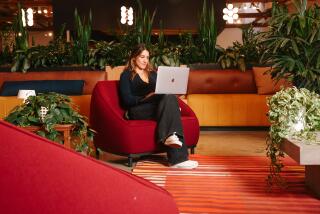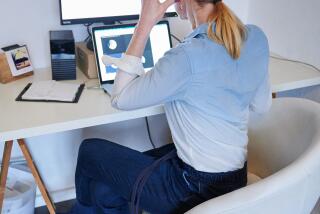On the move at work
- Share via
Nearly all of us need to make more time for fitness. Finding that time, though, can seem impossible.
But what if you could wedge that workout in at work? If it sounds far-fetched (or a great way to get yourself fired), listen up.
Dr. James Levine, an obesity expert at the Mayo Clinic, says Americans don’t need to log more time at a gym. Instead, they need to banish their sedentary ways by incorporating easy bursts of activity from dawn to dusk.
He calls it NEAT fitness, which stands for non-exercise activity thermogenesis. In layman’s terms, it means cranking up the body’s calorie-burning abilities by weaving in near-constant movement -- such as standing, walking, even pacing -- at every opportunity. Becoming a body in motion that stays in motion could help you burn 500 or more extra calories a day. Combine that with smart food choices, and we could be well on our way to reversing the nation’s ever-expanding waistline.
And Levine believes the best place to start is in the workplace.
If you’re rolling your eyes, you might be guilty of what Levine calls “1930s thinking, to see employees [and the workplace] as merely tools of productivity.” But “the really cool companies” -- Google, Yahoo, Apple -- “take the health and the happiness of their employees seriously,” Levine said.
It’s not just for altruistic reasons, of course. It’s easier to keep health costs in line when employees are healthier, and a healthier workforce is a more productive workforce, he said. “A healthy workplace is the way of the future.”
Such a future might resemble the San Clemente headquarters of Stance, an upscale sock company that tailors its line to Southern California’s snow, skate and surf culture.
Chief Executive Jeff Kearl says the 4-year-old company has spent more than $100,000 on employee perks such as a basketball court, a skateboard half-pipe, game tables and showers. A chef prepares healthful breakfasts and lunches. (On a recent Friday, employees rolled in to an array of freshly blended juices and homemade yogurt. Lunch revolved around a crunchy kale salad.) A gym, personal trainers and classes are coming shortly.
And it’s not unusual for employees to clear out and head for the beach (just up the street) when the waves are just right.
“It may be hard for people to believe, but we have zero abuse,” said Kearl, whose 35-person office runs by a “freedom and accountability” philosophy that loosely translates as: Just get your work done, OK?
Not every company is run like Kearl’s or will hire the likes of a Levine to revamp its culture and facilities to make health and fitness a priority. So we asked Levine to help us come up with ideas (at right) to try now. For free.
We realize all these ideas won’t work for you.
But maybe a third of them will. And that would help you meet the U.S. Department of Health and Human Services recommendation that adults get at least 150 minutes a week of “moderate-intensity exercise” -- the equivalent of walking at a pace of 20 minutes per mile.
If you have a suggestion to add to our list, let us know: Tag us on Twitter and Instagram using the hashtag #LATFit and #PedometerWars.
--
(BEGIN TEXT OF INFOBOX)
--
Options to help you break that office chair inertia
Is it time for a standing desk?
To be honest, there is debate about whether a standing desk -- in and of itself -- can help reverse a sedentary lifestyle. But experts say it’s a step in the right direction.
At the very least, a standing desk can serve as a constant reminder to weave more activity into our everyday lives, said Dr. James Levine, an obesity expert at the Mayo Clinic who encourages businesses to embrace healthier workplaces.
Before you spend a penny, why not just find an empty box or milk crate and turn it upside down? Look for opportunities to use it as a perch to review notes, talk on the phone, sort mail, etc. Sit only when you need to focus on your computer screen. This experiment will help you decide whether one of the following might suit your needs:
1. Got a treadmill acting like a clothes hanger in your spare bedroom? Then you could be halfway to a walking desk. Yes, a walking desk -- a desk that wraps around a treadmill -- is the hot new corner office accessory. One model on the market is the TrekDesk, an adjustable-height U-shaped desk that curves across the front of your treadmill, leaving space for a laptop, an inbox, a phone and more. Yes, there are cup holders. Stroll along at a gentle pace -- up to 2 miles an hour -- while working. Or stand still when you need to focus. Price: $479.
2. In all likelihood, you’ll want a workstation that allows you to stand and sit. UpLift has an extensive line of desks in a variety of sizes, prices and designs that come with a motor that will allow you to easily switch back and forth. One we like is the UpLift 900, priced at $769.
3. Money is no object? Check out the $8,000 Elliptical Machine Office Desk at Hammacher Schlemmer. It’s spacious enough to have an area for just standing.
--
Rene Lynch
--
Fitness trackers worth checking out
Fitness trackers are all the rage. But how to choose one? First off, know what you’re looking for. Fitness trackers and pedometers are great for walkers and runners but not as adept if, say, you’re a swimmer or cyclist. And if you are not a gadget geek, save yourself the grief and go for a simple model. Shop around, read reviews and ask friends for recommendations. In the meantime, here are three of our go-to devices:
--
The Force: Fitbit’s watch-like tracker is dominating its niche in the market. You can, at a glance, see how many steps you’ve taken or how many stairs you’ve scaled, and it even tracks sleep patterns. Setup requires nominal tech know-how, and it syncs across a variety of devices. Fitbit’s software also allows you to track food intake, if you are so inclined. Some have complained about irritation with the wristband, but overall it wins raves. $129.95 at Fitbit.com
--
The One: This model is also from Fitbit, underscoring just how well this brand performs. Tracks steps, stairs, sleep and more. A little larger than a AA battery, the One can be discreetly worn on your waistband or bra strap, or slipped into your pocket. However, its size and placement require vigilance to make sure it doesn’t end up in the washing machine, or, um, knocked into a toilet bowl. Setup and syncing are similar to the Force. $99.95 at Fitbit.com
--
Omron HJ-112. It doesn’t get any simpler than this, which is why we love this pedometer. Just strap on and go. Slide it into your pocket, or use the holder to wear it on your waistband, but just remember it’s there, especially when going to the bathroom. (It’s powered by a watch battery and has a slightly bulkier profile when used with its holder.) If you like this model, you might want to buy two. Omron appears to be phasing it out in favor of sleeker models. About $28 on Amazon.
--
Rene Lynch



